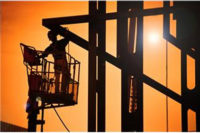
In October 2009AMI Plasticslaunched the first international conference on plastics in sewerage and drainage pipes in Germany. Noru Tsalic began by detailing the trends and developments in the European market, predicting a decline in overall new construction into 2010. However there is also renewal of existing infrastructure such as ageing pipelines and the need for full networks of sewerage pipes in Eastern and Central Europe.
For example, Water UK estimated that 10.4 billion GBP would need to be invested in sewerage systems between 2005-2010. PVC currently dominates the plastics pipes segment, followed by PE, PP and GRP. However, for larger pipes of diameter over 700mm, more traditional materials such as concrete are still prevalent.
Solvinhas been developing twin wall PVC pipes for sewerage and rainwater drainage. In impact tests the outer layer takes the brunt of the force leaving the inner layer relatively undamaged. Only one layer needs to have an impact modifier to cut costs: dies and feed-block have to be adapted but existing extruders and haul-off can be used.
New grades of high modulus PP (PP-HM) have been developed for this market, where block copolymers have been in use for over 30 years. Borealis has a new copolymer PP material with a high crystallinity and a dispersed rubber phase to improve impact strength. There is better performance and lower weight per meter.
Lyondellbasell has also developed new PP-HM as defined in EN 1852. It has very high stiffness with E-modulus > 1700 MPa, high wear resistance (important when conveying high levels of solids) and good impact resistance at low temperature. This has been used in Gigapipe structured twin-wall sewerage pipes.Ineos Olefinsand Polymers is another company with new PP-HM material and has highlighted the enhanced processability, with one study of smooth pipes reducing weight by 15% and increasing output by 7%.
Sicahas an inline thermoforming system to produce sockets on PP and HDPE corrugated pipes. A rubber coupling partially expands the pipe end and it is enlarged again with heated mechanical inserts, forced cooling contracts the pipe back onto the mould and into the final shape.
Pipeline Rehab
Pipeline rehabilitation is a common use of polymers.LGA Bautechnikhas used a close-fit, cured in place pipe (CIPP) system for pipes from 100mm to 2000mm diameter, including egg and other shapes. It also uses pre-deformed PVC and HDPE pipe for insertion and then re-forming using heat: this technique can be used in pipes from 100 to 500mm in diameter.In some cases an HDPE pre-liner is used followed by a liner with injection spacing so that mortar can be injected around the thermoplastic insert. In the Wuerzburg pipe rehabilitation where the existing pipe was not able to carry load, mortar was injected around a GRP pipe insert. This mortar injection partly fills cracks in the existing pipe. PE pipes have been used to reline waste water pipelines byHessel Ingenieurtechnikusing rolldown, swagelining or sublining techniques. Light-curing pipe lining was used byBrandenburger Linerin Bremen in an oval-shaped sewer. The liner is pulled into the sewer and expanded with compressed air. It is then cured with UV light.
Bacteria in sewage can cause corrosion and the aggressiveness depends on factors such as acidity and the sulfur level, as well as flow velocity and temperature.Flowtite Technology has been collecting test data on the chemical resistance of GRP pipes for 30 years and the experiment is still running. Extrapolation indicates a potential lifetime of over 150 years.
In one case in Riyadh a sewer pipe was installed in 1980 and inspected by Bureau Veritas: the internal surface remains smooth and colour intact except for a few brown stains, while the pipe stiffness has only reduced by 12.5%. In a second case of an outfall pipe in operation in Norway for over 33 years, there were no signs of ageing: the pipe was taken out of service due to failure of the steel supports.
Pipe Joining Systems
Industrie Poliecohas developed corrugated pipe with outer and inner layers of HDPE and a core in steel coated with PE. A rotomoulded male PE coupler is welded to one end of each section. The resulting pipe is inert to chemicals, resistant to abrasion, lightweight and shows high resistance to deformation. It has been used in sites across Europe.Friatecspecializes in pipe joining systems and has worked on joining PE pipe to concrete inspection chambers in sewerage systems. Electrofusion systems leave a smooth internal surface. The company also has transition fittings for connecting PE to materials such as PVC and clay pipes. Plasson works in a similar market and offers fully welded PE80 and PE100 systems for non-pressure waste water applications. Its electrofusion couplers are specified for operating pressures of 10 bars and it supplies adapters that can be integrated into concrete chambers for joining PE pipes.
Joints need to be tightly sealed and this has traditionally been achieved with rubber, howeverDSM Thermoplastic Elastomershas been supplying thermoplastic vulcanisates (TPV) into this market. The TPV can be injection moulded as one component whereas a typical SBR design involves a ridged ring and a rubber seal. The material shows good ozone resistance, thermal and UV stability, good chemical resistance and design flexibility.
Source: AMI Plastics

